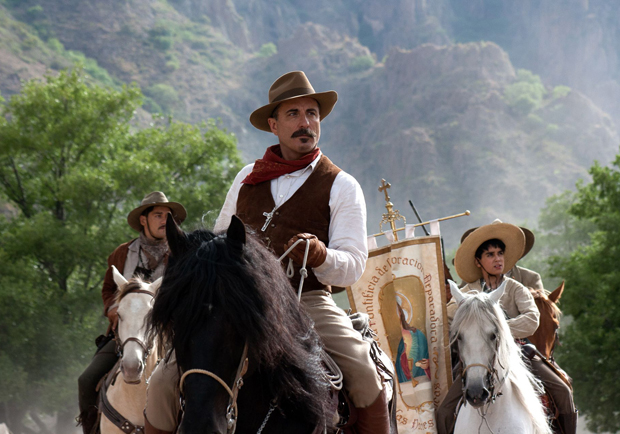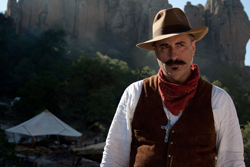The 1920s Cristero rebellion, or the Cristiada, during the latter part of the Mexican Revolution was one of the largest insurgencies in Western history, but few Americans today have heard of it. The closest familiar point of contact is probably Graham Greene’s celebrated novel The Power and the Glory, set during the continued anticlerical persecutions of the 1930s after the end of the Cristero conflict.
For Greater Glory is set a decade earlier. The story takes place during the presidency of Plutarco Elias Calles (Rubén Blades), who held office from 1924 to 1928 and continued for a half dozen years afterward to govern the nation through puppets. Calles was a fanatical opponent of Mexico’s Catholic Church, which had opposed the revolutionary generals in the turmoil following the Mexican Revolution. He promoted ruthless enforcement of restrictions on the church under the 1917 Constitution, compounding them with draconian punitive measures.
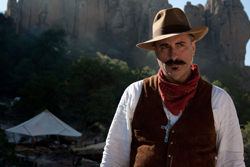
Calles’s oppression was met first by peaceful resistance and then by violence, with a decentralized movement of peasant forces—derisively dubbed Cristeros or “Christers” by their opponents—enjoying some startling successes against the federales, particularly under the command of General Enrique Gorostieta Velarde (Andy Garcia), an accomplished military leader who served in the Federal Army before becoming an unlikely leader of the Cristero forces. Spearheaded by Mexican producer Pablo José Barroso, For Greater Glory is one of the most expensive and ambitious films in Mexican filmmaking history. Special effects guru Dean Wright, whose credits include the Lord of the Rings and Narnia films, makes his directorial debut, imbuing the film with an aura of Western saga.
The film enjoys a solid cast led by Garcia, Oscar Isaac (The Nativity Story) and Santiago Cabrera (Heroes), with Peter O’Toole, Eva Longoria (Desperate Housewives), and Bruce Greenwood effective in smaller roles. Eduardo Verástegui (Bella) has a cameo as a pacifist lawyer named Anacleto Gonzalez Flores, and 15-year-old Mauricio Kuri, a Mexico City native, makes a likable debut as José Luis Sanchez del Rio, a young Cristero tortured and killed by federales. Both Flores and Sanchez were declared martyrs and beatified by Pope Benedict XVI in 2005.
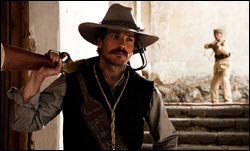
Garcia stars as Gorostieta, depicted as benignly agnostic, supportive of religious freedom, and indulgent of the pious faith of his wife Tulita (Longoria), who raises their children in the faith with his consent. The real Gorostieta was apparently more complicated: a committed anticlerical who was contemptuous of religion, he nevertheless supported limited government toleration of religion.
Though he openly sneered at the faith of his subordinates, including his clerical lieutenants, as a Cristero leader Gorostieta wore a large crucifix around his neck—and if the depiction of Gorostieta shouting the famous Cristero slogan “¡Viva Cristo Rey!” (“Long live Christ the King!”) seems paradoxical, it’s probably accurate. Less accurate, probably, is Gorostieta’s edifying character arc toward faith.
That’s typical of the movie’s sanitized, faith-friendly approach to its subject matter. The real Father Vega was a vigorously irreligious man whose carnal and murderous ways would make Greene’s frail “whisky priest” look like Francis of Assisi. The film’s Vega is more like the historical Father Pedroza, an earnest priest despite his military involvement. An infamous atrocity from Vega’s career involving a massacre of civilians is depicted in the film as an accident.
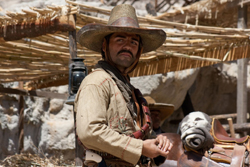
Despite its schematic simplicity, For Greater Glory effectively taps into timely themes of religious freedom and intrusive government policy, as well as the mixed outcomes of U.S. vested interests in complex foreign affairs. The film shows U.S. ambassador Dwight Morrow (Greenwood) working to negotiate a peace deal with the Calles government partly to ease the flow of oil to the United States—a flawed deal that ultimately goes through, essentially selling out the Cristero cause.
For Greater Glory bears witness to continuing religious persecution after the Cristiada ended. Even today, after a recent narrow vote in the Mexican Senate to expand religious freedom, freedom of religion in Mexico remains incomplete. Almost a century later, the promise of the Cristero cause remains unfulfilled.
Talk About It
Discussion starters- Did you know anything about the Cristeros War before seeing this film? How has the film helped you to understand it better? Do you have unanswered questions about the conflict? What are they?
- How does General Gorostieta’s attitude toward faith change during the film? Why do you think it changes? Do you think the film’s depiction is persuasive? Why or why not? Have you ever had doubts or crises of faith? How have your beliefs been influenced throughout your life?
- Some of the clergy offer no resistance to the federales and allow themselves to be executed. Others participate in the resistance and even take part in military action. Is one approach better than the other? Is either unacceptable? Should clergy hold themselves to different standards from other people? Why or why not?
- What do you think of Gorostieta permitting young José Reyes Vega to join the Cristeros community? Was it a responsible thing to do? Is allowing minors to participate directly in a dangerous undertaking such as a war effort ever morally legitimate? Why or why not?
- How is the movie’s theme of religious freedom applicable to issues in the world today? How are the issues faced in the movie different from issues we face today? Which challenges do you think are more serious? Why?
The Family Corner
For parents to considerFor Greater Glory is rated R for graphic wartime violence and some disturbing images, including torture and executions of youths and executions of clergy. Some parents may be concerned about clerical involvement in military action. The film also depicts desecration of churches and sacred articles.
Photos © ARC Entertainment
© 2012 Christianity Today. All rights reserved. Click for reprint information.

